

 |
 |
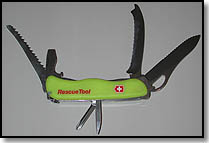 What can one say about moribund Victorinox except that they seem to be forsaking the knives that built the company. They would rather sell you watches, luggage, clothing, packs; almost anything but knives. Well, if you insist� It's been years since we saw much of anything new in their Swiss Army Knife line beyond minor variations on some existing models. It would seem, from all appearances, that they have lost their passion. This year they had a single new knife of note. Pretty sad, truth be told.
What can one say about moribund Victorinox except that they seem to be forsaking the knives that built the company. They would rather sell you watches, luggage, clothing, packs; almost anything but knives. Well, if you insist� It's been years since we saw much of anything new in their Swiss Army Knife line beyond minor variations on some existing models. It would seem, from all appearances, that they have lost their passion. This year they had a single new knife of note. Pretty sad, truth be told.
Victorinox's new Rescue Tool is based on their 111mm large frame Swiss Army Knife. It includes the one-hand opening partially serrated blade we first saw on the One-Hand Trekker and also includes a screwdriver/cap lifter, awl and Phillips driver as used on that same knife. Where the OHT has the can opener, the Rescue Tool has a replaceable glass breaker that protrudes from the handles.
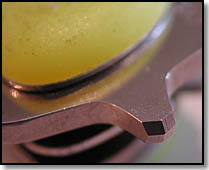 The glass breaker is faceted, ground to a point on four sides. A spare glass breaker is provided in case you dull the tip, a drawback to using the standard relatively soft Victorinox steel instead of carbide or higher hardness on the heat treat/higher grade of steel.
The glass breaker is faceted, ground to a point on four sides. A spare glass breaker is provided in case you dull the tip, a drawback to using the standard relatively soft Victorinox steel instead of carbide or higher hardness on the heat treat/higher grade of steel.
Next to the one-hand opening blade is a curved fully serrated seat belt cutter blade similar to those they have used on the earlier Fireman of Parachutist models. This has a finger hook at the end for easier opening with gloves on. We're not sure why they would keep the serrations on the main blade while having the fully and better serrated seat belt cutting blade also included (other than they didn't have to produce a new blade, they just use the same as the One-Hand Trekker). The serrations on the main blade simply limit its usefulness, from our perspective.
 On the other end is a somewhat controversial tool, a replaceable glass saw designed to saw through safety glass, such as used in all modern windshields. A spare saw blade is included. Victorinox make a very big deal about this. That it works is proven in their video. Whether it is practical in the real world is another question. Do they not have electricity and power tools in Switzerland? Did they do away with fire axes?
On the other end is a somewhat controversial tool, a replaceable glass saw designed to saw through safety glass, such as used in all modern windshields. A spare saw blade is included. Victorinox make a very big deal about this. That it works is proven in their video. Whether it is practical in the real world is another question. Do they not have electricity and power tools in Switzerland? Did they do away with fire axes?
Standard means to accomplish this in the U.S. is to use a Sawzall type portable power reciprocating saw that makes much quicker work of things. Failing that, an axe can be used quite effectively and is much quicker than the Rescue Tool's glass saw. We're sort of at a loss to understand what the big deal is with this glass saw in the modern world. We've got a sample and have given it to ETS' resident firefighter/paramedic for some real world testing and we'll be reporting back our findings. Perhaps we're missing something.
The handles are luminescent and glow in the dark. We can confirm that if they get a good charge they will stay brightly illuminated all night long and if exposed during use, even at night, will glow enough to be easily found if dropped. Interestingly, even while stored in the pouch, the side exposed at the top of the pouch is illumintaed over the whole scale, not just the exposed portion.
A bright red nylon pouch with a metal logo and a short nylon cord lanyard are also included. Our tester found the lanyard to be annoying and took it off. Somewhat to our surprise, most of the firefighters we spoke with didn't like the bright red color of the pouch and would prefer black. MSRP is $80

 While Victorinox has hardly done anything much with their knife line for a couple years, their sister company Wenger, and former competitor, is moving at the Swiss equivalent of warp speed. It's been two years since Wenger introduced their innovative Evolution series with ergonomic handles that broke the mold for a Swiss Army Knife. Now they've taken another big step with the EvoGrip series that incorporate textured rubber inlays into those same handles. From my perspective, this is another huge leap in functionality and safety.
While Victorinox has hardly done anything much with their knife line for a couple years, their sister company Wenger, and former competitor, is moving at the Swiss equivalent of warp speed. It's been two years since Wenger introduced their innovative Evolution series with ergonomic handles that broke the mold for a Swiss Army Knife. Now they've taken another big step with the EvoGrip series that incorporate textured rubber inlays into those same handles. From my perspective, this is another huge leap in functionality and safety.
Even with the original improved Evo handles, they were still slippery smooth plastic. While the more ergonomic handles had an advantage over the standard handles in wet conditions or with sweaty hands, it was still not easy to grasp and without any finger guard, too easy to slip a finger onto the blade edge.
The EvoGrip and its rubber gripping surfaces significantly improve grippability. We couldn't test in wet conditions at the show, but once we got a sample at home we were able to confirm that it makes an even bigger difference with wet hands. Even with soapy hands to simulate slippery blood, it still retained a notable advantage over the smooth Evo handles. Ironically, the only nit we can pick about this improvement is the Wenger Swiss Cross logo which is smooth plastic at exactly the least desireable location, where your thumb naturally rests when gripping the knife. It's not a big deal and there's grippy material surrounding it, but it was the sort of thing that we noticed once we had a chance to play with the knives at home.
The only real problem, from my perspective, is that while they started off with five knives with the new EvoGrips, only two have a locking main blade, the S557 and S54 with 13 implements/19 functions and 18 implements/32 functions, respectively. The less fully equipped, more pocketable versions don't have a locking blade. The corkscrew has been replaced with a Phillips screwdriver on two of the lesser models, but the base still has the corkscrew. The locking blade models retain the corkscrew, but also have a much better Phillips among the regular foldout tools. (Click here for images of all five models showing all their implements.)
Alas, none really combine an optimum set of tools for emergency wilderness use in a modest size package. But, there's always hope for next year. Last time they followed up the first year with a much wider range of locking blade versions. The standard size Swiss Army Knife will never be the same again. If your EDC is a Swiss Army Knife, one of the EvoGrips would be your best choice if safety is a consideration. Moreover, they really look very cool. MSRP for the EvoGrips ranges from $35 to $116.
Wenger also introduced some new variations of the existing Evo line, the S18 and S585, locking blade versions of two of the original Evo models. Also introduced were the first two black versions of the full size Evo line, the Evo 16 and Evo 18. I have to say that the Evo handles look particularly classy in black. Also added were pink and translucent "watermelon" colored versions of the Evo 81, the Evo version of the popular keychain size Esquire.
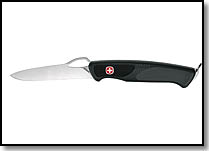 As If that was enough for the staid Swiss firm, Wenger also completely redesigned their larger size Swiss Army Knives. The new Ranger series represents another break with tradition, incorporating more ergonomic handles, shades of the Evolution series, and for the first time ever for Wenger, one-hand opening blades on some models. Why they aren't all one-hand opening, at least as sold in the U.S., is beyond me, but at least they are making progress.
As If that was enough for the staid Swiss firm, Wenger also completely redesigned their larger size Swiss Army Knives. The new Ranger series represents another break with tradition, incorporating more ergonomic handles, shades of the Evolution series, and for the first time ever for Wenger, one-hand opening blades on some models. Why they aren't all one-hand opening, at least as sold in the U.S., is beyond me, but at least they are making progress.
The new blade is a more versatile and stronger spearpoint style in the SAK tradition (and like Victorinox uses), rather than the weaker clip point Wenger had used on their previous large size folders. That alone would be great news.
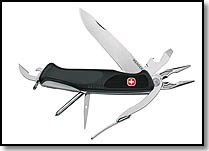 If you want a full sized blade of very nearly 4 inches (3.9) and needle nose pliers or an electrician's tool or full-sized scissors, the new Rangers can also accommodate you with tools that fold out from the handles. As you might expect, the scissors are spring-loaded, just like their smaller siblings, but so also are the pliers and electrician's tool. Spring-loaded pliers are easier to use in many circumstances compared with those that require you to both open and close the handles. The pliers and scissors do add a fair bit of weight and bulk to the knives, no surprise.
If you want a full sized blade of very nearly 4 inches (3.9) and needle nose pliers or an electrician's tool or full-sized scissors, the new Rangers can also accommodate you with tools that fold out from the handles. As you might expect, the scissors are spring-loaded, just like their smaller siblings, but so also are the pliers and electrician's tool. Spring-loaded pliers are easier to use in many circumstances compared with those that require you to both open and close the handles. The pliers and scissors do add a fair bit of weight and bulk to the knives, no surprise.
The new sculpted handles provide a much better grip that is further enhanced with checkering on the forward portion of the handle. There's even a bit more pronounced downward curve at the front, compared to their original designs, to serve as a bit of a finger guard. No pocket clip, unfortunately.
Models range from the simple Ranger 51 and 151 (the 100 series have partially triple point serrated blades) with just the one-hand opening blade to a variety of multi-implement versions, some with one-hand opening blades and some with partially serrated options. Thankfully, it appears that the more versatile plain edge is standard, at least for now. (Click here to view all the models in the Ranger series.)
Somewhat incomprehensibly, at least to us, their equivalent of the popular Victorinox One-Hand Trekker, one of the best combinations of blade and tools in this new line, doesn't have a one-hand opening blade. Go figure... One is led to wonder if parent company Victorinox, who bought Wenger to prevent it from falling into non-Swiss hands, has reneged on their pledge to allow the companies to operate independently and shortsightedly killed a one-hand opening blade on that model to prevent competition with their own popular model. The Wenger spokesperson declined to comment on this speculation.
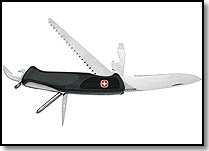 The blades lock with a liner lock that had us baffled for a brief moment because there's no relief to easily reach the liner to release it. The secret is the Swiss Cross Wenger logo in the handle that disguises a button release. Pressing the button slides a cam that releases the liner lock. Very clean and we didn't notice any tendency to unlock the blade while gripping the handle tightly. We'll have to do some real field testing to make sure that's not an issue.
The blades lock with a liner lock that had us baffled for a brief moment because there's no relief to easily reach the liner to release it. The secret is the Swiss Cross Wenger logo in the handle that disguises a button release. Pressing the button slides a cam that releases the liner lock. Very clean and we didn't notice any tendency to unlock the blade while gripping the handle tightly. We'll have to do some real field testing to make sure that's not an issue.
The one-hand opening is via a large hole in the blade that I won't even try to describe geometrically(see image). There is jimping on the base of the spine and on ramp over the hole to serve as a thumb rest on the one-hand openers. It's a bit steep, but it works. The non-one-hand opening blade (again, why?) has jimping on the spine of the blade at the base. The mechanism is basically still a slipjoint, so it's not as easy to open the blade against the spring as it would be with a conventional one-hand opener without any such resistance, but it isn't all that difficult and works adequately.
Prices are quite reasonable, with an MSRP of $36 to $85
The new EvoGrips and Ranger series show that while they may be slow learners, the Swiss can be taught new tricks. While there's still a long ways to go before Wenger, or its parent Victorinox for that matter, enters the 21st century with regards knife design and features, Wenger at least is making progress that was unthinkable just a few years ago.
| SHOT Show 2007 Report - Knives (click to return to first page) |
| 1 2 3 4 5 6 |
| Return to SHOT Show 2007 Report home page |
| SELECT AND USE OUTDOORS AND SURVIVAL EQUIPMENT, SUPPLIES AND TECHNIQUES AT YOUR OWN RISK. Please review the full WARNING & DISCLAIMER about information on this site. |
Publisher and Editor: Doug Ritter
Email: Doug Ritter
URL:
http://www.equipped.org/shot_show_2007_knives6.htm
First Published: February 11, 2007
![]()
Email to: [email protected]
|